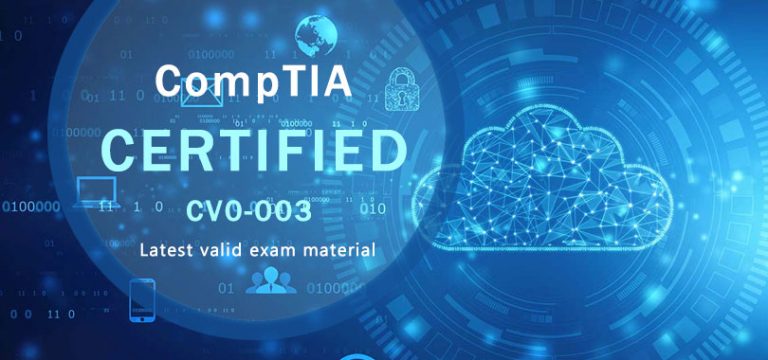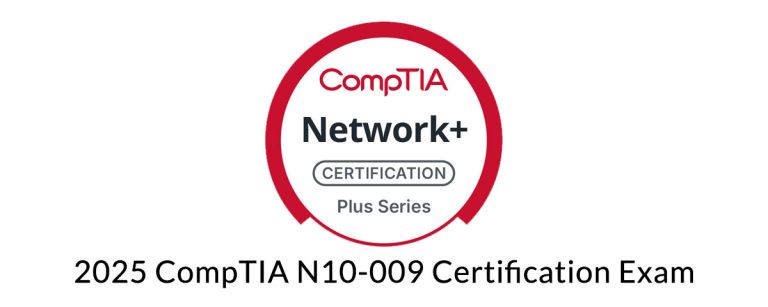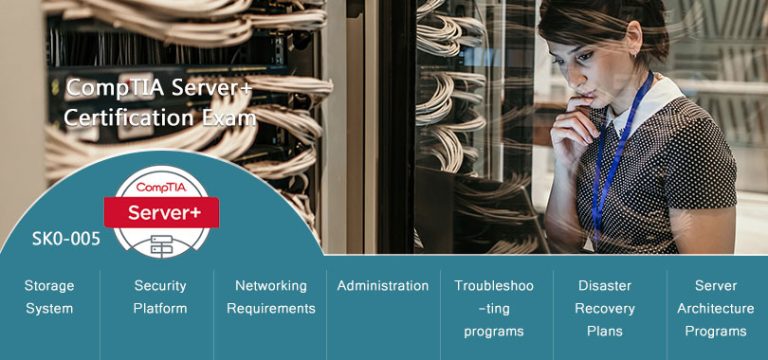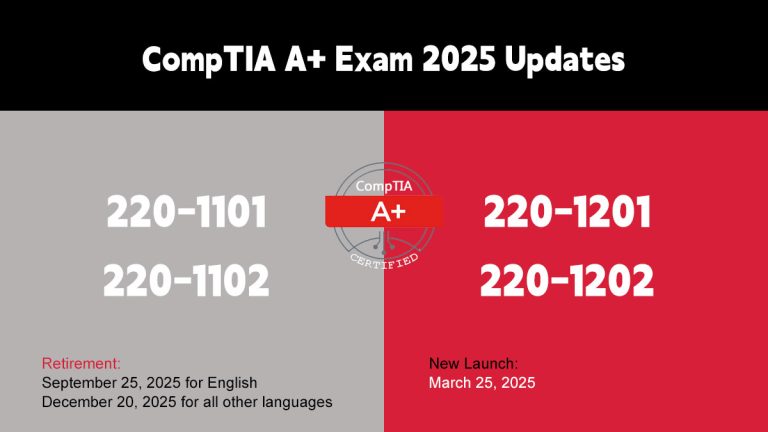The CompTIA Cloud+ CV0-004 exam was launched in September this year. Candidates should pay more attention to the difference from the previous CV0-003 and how to effectively study and pass the exam. The following will share the differences of the new CompTIA Cloud+ and how to Passed the CV0-004 exam.
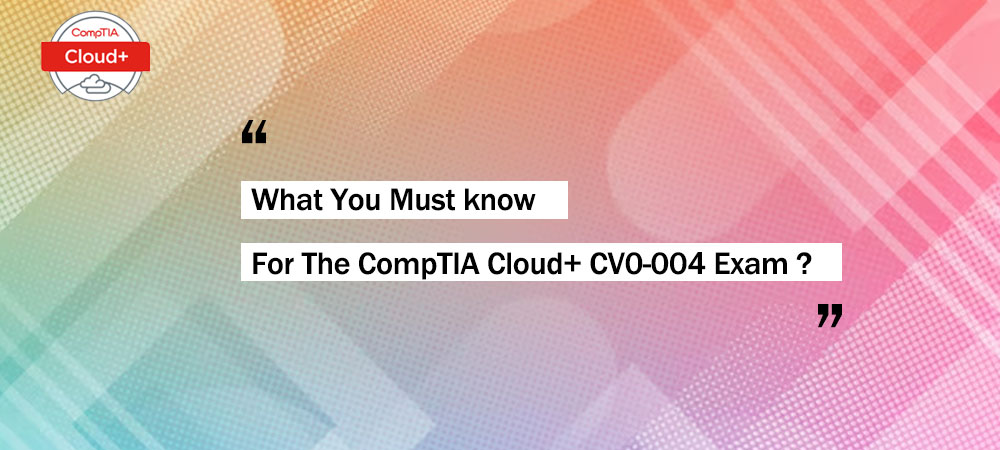
What is CompTIA Cloud+ CV0-004?
Cloud+ certification is a vendor-neutral body of knowledge that covers basic cloud design, management, security, and troubleshooting concepts.
Because it uses standard vocabulary and is not focused on any one cloud service provider, it can help prepare candidates for working with any cloud service. It also involves private cloud and multi-cloud deployments. The current old version of CV0-003 can still participate until it is retired in early 2025.
What is the difference compared with CV0-003?
CV0-004 focuses more on DevOps integrating cloud practices into a company’s other automation, orchestration, and continuous integration/continuous delivery (CI/CD) methodologies.
- Comply with industry standards, including SOC 2 (Systems and Organizational Controls 2) and PCI DSS (Payment Card Industry Data Security Standard).
- Data sovereignty, ownership and location.
- Container management and security, including privileged and unprivileged access.
- Version control concepts such as infrastructure as code and development projects.
- CI/CD pipeline tools and repositories.
How do you pass the CompTIA Cloud+ CV0-004 exam?
- CompTIA cloud+ official online learning
- CompTIA cloud+ cv0-004 training (udemy,cbtnuggets)
- Self-study (not recommended, it is difficult to obtain the latest materials for self-study)
- Use valid CompTIA cloud+ cv0-004 dumps material
What is valid CompTIA cloud+ cv0-004 dumps material? Really complete coverage of the knowledge and skills required for CompTIA Cloud+:
- Understand cloud architecture and design concepts.
- Implement and maintain a secure cloud environment.
- Successfully provision and configure cloud resources.
- Demonstrate the ability to manage operations throughout the cloud environment life cycle using observability, scaling, and automation.
- Understand fundamental DevOps concepts related to deployment and integration.
- Troubleshoot common issues related to cloud management.
All materials are guaranteed to be up-to-date, timely and effective. Currently, the Leads4Pass CompTIA Cloud+ CV0-004 dumps is already the latest! Contains 285 latest exam questions and answers, as well as professional analysis, fully matching the CompTIA cloud+ certification exam.
Best of all, you can verify practice tests online and confirm before choosing.
The latest CompTIA cloud+ cv0-004 exam questions and answers
| From | Number of exam questions (Free) | Download Full | Related |
| Leads4Pass | 15Q&A | 285 Q&A | CompTIA Cloud+ |
Question 1:
A company has applications that need to remain available in the event of the data center being unavailable. The company\’s cloud architect needs to find a solution to maintain business continuity.
Which of following should the company implement?
A. A DR solution for the application between different data centers
B. An off-site backup solution with a third-party vendor
C. laC techniques to recreate the system at a new provider
D. An HA solution for the application inside the data center
Correct Answer: A
A disaster recovery (DR) solution is a set of policies, procedures, and tools that enable an organization to restore or continue its critical functions in the event of a natural or human-induced disaster. A DR solution for the application between different data centers means that the application is replicated or backed up to another location that is geographically separated from the primary data center.
This way, if the primary data center becomes unavailable due to a power outage, fire, flood, cyberattack, or any other cause, the application can be switched over to the secondary data center and resume its operations with minimal downtime and data loss. This solution ensures business continuity and high availability for the application and its users.
References: CompTIA Cloud+ CV0- 003 Study Guide, Chapter 5: Maintaining a Cloud Environment, page 221-222; Disaster recovery planning guide.
Question 2:
A cloud engineer wants to deploy a new application to the cloud and is writing the following script: Which of the following actions will this script perform?
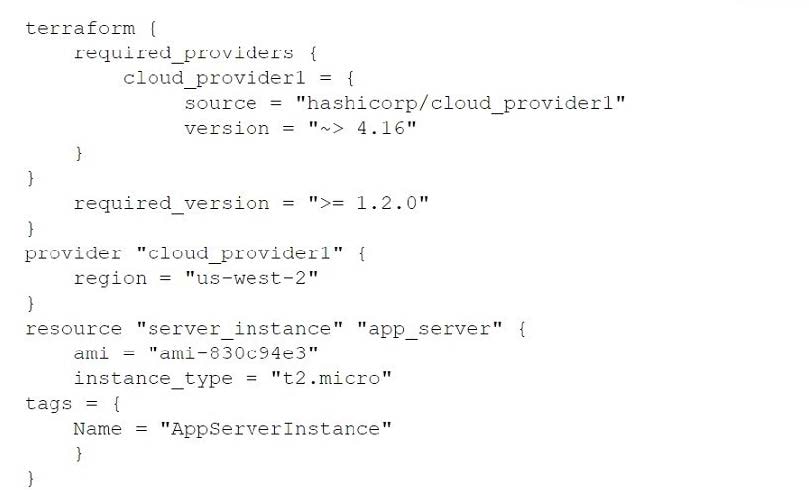
A. Upload a new VM image.
B. Create a new cloud resource.
C. Build a local server.
D. Import a cloud module.
Correct Answer: B
The script shown is written in Terraform, which is an infrastructure as code (IaC) tool used for building, changing, and versioning infrastructure safely and efficiently.
This particular Terraform script specifies arequired provider and its version, the Terraform version, sets the cloud provider\’s region, and then defines a resource for a server instance with a specific AMI ID and instance type. It also includes tags for the instance.
The action this script will perform is to create a new cloud resource, specifically a server instance on the cloud provider\’s platform.
References: CompTIA Cloud+ Study Guide (V0-004) by Todd Montgomery and Stephen Olson
Question 3:
A banking firm\’s cloud server will be decommissioned after a successful proof of concept using mirrored data. Which of the following is the best action to take regarding the storage used on the decommissioned server?
A. Keep it temporarily.
B. Archive it.
C. Delete it.
D. Retain it permanently
Correct Answer: B
When a cloud server is decommissioned after a proof of concept, the best action to take regarding the storage used on the server is to archive it. Archiving ensures that the data is kept in a less accessible but secure storage service, which may be required for regulatory or compliance reasons, especially for a banking firm.References: Data management strategies, including archiving decommissioned data, are covered in the CompTIA Cloud+ examination objectives, particularly within the domain of management and technical operations.
Question 4:
A cloud engineer is troubleshooting a connectivity issue. The application server with IP 192.168.1.10 in one subnet is not connecting to the MySQL database server with IP 192.168.2 20 in a different subnet. The cloud engineer reviews the following information:
Application Server Stateful Firewall
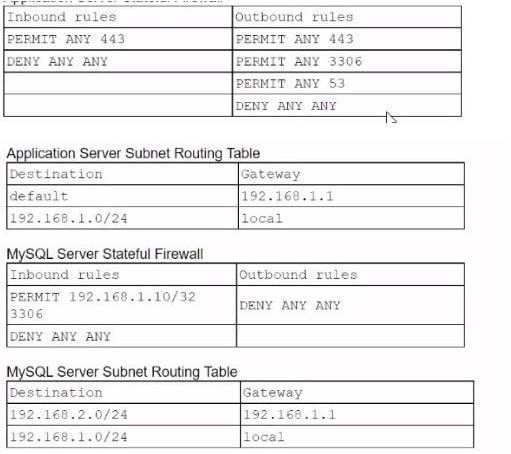
Which of the following should the cloud engineer address lo fix the communication issue?
A. The Application Server Stateful Firewall
B. The Application Server Subnet Routing Table
C. The MySQL Server Stateful Firewall
D. The MySQL Server Subnet Routing Table
Correct Answer: C
The connectivity issue between the application server and the MySQL database server in different subnets is likely due to the MySQL Server Stateful Firewall\’s inbound rules. The application server has an IP of 192.168.1.10, but the MySQL server\’s inbound rules only permit IP 192.168.1.10/32 on port 3306.
This rule allows only a single IP address (192.168.1.10) to communicate on port 3306, which is typical for MySQL. However, if the application server\’s IP is not 192.168.1.10 or the application is trying to communicate on a different port, it would be blocked. To fix the communication issue, the cloud engineer should address the inbound rules on the MySQL Server Stateful Firewall to ensure that the application server\’s IP address and therequired port are allowed.
References: Based on the information provided in the question and general networking principles.
Question 5:
Which of the following are best practices when working with a source control system? (Select two).
A. Merging code often
B. Pushing code directly to production
C. Performing code deployment
D. Maintaining one branch for all features
E. Committing code often
F. Initiating a pull request
Correct Answer: AE
Best practices when working with a source control system include merging code often to ensure that changes from different team members are integrated regularly, reducing integration issues. Committing code often is also recommended to save small changes frequently, which helps in tracking changes and resolving issues more effectively.
References: Source control system best practices are part of the software development and deployment guidelines discussed in the CompTIA Cloud+ examination objectives.
Question 6:
Which of the following best explains the concept of migrating from on premises to the cloud?
A. The configuration of a dedicated pipeline to transfer content to a remote location
B. The creation of virtual instances in an external provider to transfer operations of selected servers into a new. remotely managed environment
C. The physical transportation, installation, and configuration of company IT equipment in a cloud services provider\’s facility
D. The extension of company IT infrastructure to a managed service provider
Correct Answer: B
Migrating from on-premises to the cloud generally involves creating virtual instances in an external provider\’s environment and transferring the operations of selected servers to this new, remotely managed setup. This process allows organizations to leverage the cloud provider\’s resources and services.
References: The migration process and strategies are topics included in the Business Principles of Cloud Environments within the CompTIA Cloud+ curriculum.
Question 7:
A cloud administrator needs to distribute workloads across remote data centers for redundancy reasons. Which of the following deployment strategies would eliminate downtime, accelerate deployment, and remain cost efficient?
A. In-place
B. Rolling
C. Blue-green
D. Canary
Correct Answer: C
Blue-green deployment is the strategy that can eliminate downtime, accelerate deployment, and remain cost-efficient. It involves running two identical production environments, only one of which is live at any given time (blue or green).
When it\’s time to deploy, the new version is released to the inactive environment (green), which is then thoroughly tested. Once ready, the traffic is switched over, making the green environment live.
References: Deployment strategies and their impact on operations are a significant topic within the CompTIA Cloud+ examination objectives.
Question 8:
Which of the following is a difference between a SAN and a NAS?
A. A SAN works only with fiber-based networks.
B. A SAN works with any Ethernet-based network.
C. A NAS uses a faster protocol than a SAN
D. A NAS uses a slower protocol than a SAN.
Correct Answer: D
A NAS (Network Attached Storage) typically uses file-level protocols such as NFS or SMB, which are generally considered slower and less efficient than the block-level protocols used by SANs (Storage Area Networks), such as iSCSI or Fibre Channel. SANs are designed for high performance and low latency, making them more suitable for applications requiring fast and efficient storage access.
Question 9:
A cloud deployment uses three different VPCs. The subnets on each VPC need to communicate with the others over private channels. Which of the following will achieve this objective?
A. Deploying a load balancer to send traffic to the private IP addresses
B. Creating peering connections between all VPCs
C. Adding BGP routes using the VPCs\’ private IP addresses
D. Establishing identical routing tables on all VPCs
Correct Answer: B
To allow subnets on different VPCs to communicate with each other over private channels, the cloud engineer should create peering connections between all the VPCs. VPC Peering allows networks to connect and route traffic using private IP addresses without the need for gateways, VPN connections, or separate physical hardware.
References: CompTIA Cloud+ Study Guide (V0-004) by Todd Montgomery and Stephen Olson
Question 10:
A web-application company recently released some new marketing promotions without notifying the IT staff. The systems administrator has since been noticing twice the normal traffic consumption every two hours for the last three hours in the container environment.
Which of the following should the company implement to accommodate the new traffic?
A. A firewall
B. Switches
C. Ballooning
D. Autoscaling
Correct Answer: D
According to the CompTIA Cloud+ Study Guide1, autoscaling is “the ability to automatically increase or decrease the number of resources allocated to a cloud service based on the current demand”. This means that autoscaling can help a cloud environment adjust to changes in traffic and workload, such as the ones caused by the new marketing promotions.
Ballooning, on the other hand, is “a technique used by hypervisors to reclaim unused memory from a virtual machine and allocate it to another virtual machine that needs more memory”. This means that ballooning can help optimize the memory usage of a cloud environment, but it does not affect the number of resources allocated to a cloud service.
A firewall is “a device or software that monitors and controls the incoming and outgoing network traffic based on predefined rules”. This means that a firewall can help protect a cloud environment from unauthorized access and malicious attacks, but it does not affect the number of resources allocated to a cloud service.
Switches are “devices that connect multiple devices on a network and forward data packets between them”. This means that switches can help improve the network performance and connectivity of a cloud environment, but they do not affect the number of resources allocated to a cloud service.
Based on this information, I think the best answer to your question is D. Autoscaling. Autoscaling can help the company accommodate the new traffic by automatically increasing or decreasing the number of resources allocated to their web-application service based on the current demand. This can also help reduce costs and improve performance and availability.
I hope this helps you understand the concept of autoscaling better. If you want to learn more about CompTIA Cloud+, you can check out some of these resources:
CompTIA Cloud+ : Cloud High Availability and Scaling: A video course that covers the topics of high availability and scaling in cloud environments, including autoscaling, horizontal scaling, vertical scaling and cloud bursting.
Cloud+ (Plus) Certification | CompTIA IT Certifications: The official website of CompTIA Cloud+, where you can find exam details, preparation materials, renewal information and more.
Question 11:
Which of the following industry standards mentions that credit card data must not be exchanged or stored in cleartext?
A. CSA
B. GDPR
C. SOC2
D. PCI-DSS
Correct Answer: D
The Payment Card Industry Data Security Standard (PCI-DSS) is the industry standard that mandates that credit card data must not be stored or transmitted in cleartext. It includes requirements for encryption, access control, and other security measures to protect cardholder data.
References: Official PCI Security Standards Council Site.
Question 12:
A systems administrator is planning to deploy a database cluster in a virtualization environment. The administrator needs to ensure the database nodes do not exist on the same physical host.
Which of the following would best meet this requirement?
A. Oversubscription
B. Anti-affinity
C. A firewall
D. A separate cluster
Correct Answer: B
Anti-affinity is a rule that specifies that certain virtual machines should not run on the same physical host. This can help to improve availability and performance by avoiding single points of failure and resource contention.
For example, if the database nodes are running on the same host and the host fails, the entire database cluster will be unavailable. By using anti-affinity rules, the systems administrator can ensure the database nodes are distributed across different hosts in the virtualization environment. References:
CompTIA Cloud+ CV0-003 Study Guide, Chapter 2: Deploying a Cloud Environment.
Question 13:
A cloud engineer is deploying a cloud solution that will be used on premises with need-to- know access. Which of the following cloud deployment models best meets this requirement?
A. Community
B. Public
C. Private
D. Hybrid
Correct Answer: C
A private cloud deployment model is the most appropriate when the requirement is for \’need-to-know\’ access, as it offers a more secure environment with resources dedicated to a single organization. It can be hosted on-premises or off-premises but is maintained on a private network, ensuring greater control over the data, security, and compliance when compared to other cloud models.
References: CompTIA Cloud+ Certification Study Guide (V0-004) by Scott Wilson and Eric Vanderburg
Question 14:
A cloud engineer was deploying the company\’s payment processing application, but it failed with the following error log:
ERFOR:root: Transaction failed http 429 response, please try again
Which of the following are the most likely causes for this error? (Select two).
A. API throttling
B. API gateway outage
C. Web server outage
D. Oversubscription
E. Unauthorized access
F. Insufficient quota
Correct Answer: AF
The error “http 429 response, please try again” typically indicates API throttling, where the number of requests exceeds the rate limit set by the API provider, and insufficient quota, where the allowed number of API calls within a given timeframe has been exceeded.
References: API throttling and quota management are key concepts in the management of cloud resources, as highlighted in the CompTIA Cloud+ curriculum.
Question 15:
A cloud engineer is extending on-premises services to a public cloud. The following design requirements must be considered in the overall solution:
1.
The ability to remotely connect systems from both environments
2.
No IP address conflicts or overlap
3.
Cost-effectiveness
Which of the following cloud network concepts best meets these requirements?
A. Dedicated connection
B. VPN
C. VLAN
D. ACL
Correct Answer: B
A Virtual Private Network (VPN) is the most cost-effective solution for extending on-premises services to a public cloud while ensuring secure remote connectivity. VPNs can be configured to avoid IP address conflicts and overlap by using IP address translation and tunneling techniques, making them suitable for connecting disparate environments without significant changes to the existing network infrastructure.
…
Download the latest 285 exam questions and answers: https://www.leads4pass.com/cv0-004.html CompTIA Cloud+ CV0-004 dumps
Summarize:
Learn the latest CompTIA Cloud+ exam concepts, and then use effective practical practice tests to help candidates successfully pass the CompTIA cloud+ cv0-004 exam.
Best wishes for good luck!
